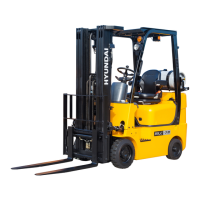3-24
·
Adjust parking brake lever as described in
chapter 3.2) Assembly.
·Carrier case cover assemble.
(Chapter 3.2) Assembly)
Trouble symptom
4. Brake does not apply
1) Service brake.
- Low or no pressure to
brake.
·Empty fluid reservoir.
·Damaged hydraulic system.
·Leakage of brake actuation fluid.
·Fill reservoir to correct level with specified
fluid.
·Check hydraulic system.
·Refer to "Brake leaks actuation fluid" in
trouble shooting.
Probable cause Remedy
2) Parking brake
·Parking brake not adjusted properly.
5. Brake does not release
1) Hydraulic system
- Vehicle does not move.
·Damaged hydraulic system.
·Check hydraulic system.
3) Differential
·Damaged diff pinion and side gear.
·Damaged diff spider.
·Damaged differential case.
·Damaged ring gear and pinion gear.
·Change the damaged part.
·Change the damaged part.
·Change the damaged part.
·Change the damaged part.
·Check piston return spring assembly.
·Check piston seals for swelling or damage
(Replace as necessary).
·Check piston seals for swelling or damage.
Replace as necessary. Purge system and
use specified fluid.
2) Service brake
- Brakes dragging.
·Damaged piston return spring
assembly.
·Piston not returning.
·Wrong cooling and/or actuation fluid
used.
6. Braking performance
1) Service brake
- Noticeable change or
decrease in stopping
performance.
·Inadequate actuation fluid supply to
brakes.
· Inadequate pressure to apply
brakes.
·Worn or damaged discs.
·Overheated seals and/or discs.
·Replenish fluid in brake system. Check for
leakage and correct cause.
·Check brake apply system. Check for leakage
in brake system or brakes, and correct cause.
·Inspect and replace discs if necessary.
As disc wear occurs, make sure brake
system can supply adequate fluid to fully
apply brakes.
·Inspect and replace discs and seals, if
necessary.
*
- Brake feel spongy/soft.
·Brakes or brake system not proper-
ly bled.
·Bleed brakes and brake system.

